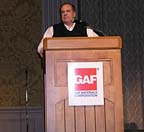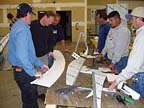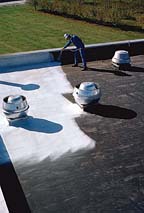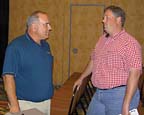Higher Education: Keeping the Roofing Industry on Top
With apprenticeship programs virtually nonexistent, the task of training and educating the guys pulling the mop and bending the panels is being fulfilled through a variety of venues, from contractors to distributors to manufacturers.
It's an investment in skill and trust in which the worker and employer team up to create a motivated workforce that's a blend of fancy equipment and old-fashioned experience.

New Opportunities
Cutting-edge technology is changing the dynamics of training and competition, even as the workforce continues to bring new challenges. Low unemployment is shrinking the labor pool, and the chronic lack of vocational training in public schools means that potential employees aren't given opportunities to learn a valuable skill, much less find out if they like it. As unions, associations and roofing contractors build their ranks from scratch, manufacturers are playing an increasingly important role.The Center for the Advancement of Roofing Excellence (CARE®) is a not-for-profit organization that will train over 20,000 people this year in various forums at a variety of sites, including plants, distributors, association meetings and conventions.
Founded by GAF Materials Corp., the program presents information on best practices for roofing contractors, installers, consultants, building owners, architects and anyone else in the roofing equation.
"I think we invest more in education that anyone in the industry," says Dave Harrison, senior vice president, marketing, contractor services and corporate development for GAF, adding that the seminars are designed to educate, not make a sales pitch. The focus is on driving home key techniques and concepts. "You don't do that by bragging about your company. You do it by building trust."
Many architects have a keen interest in roofing design, a topic that is sparsely covered in many schools. Building owners and maintenance personnel are also frequent attendees, eager to find their way through a myriad of roofing choices. Differences in contractors, products and warranties can be overwhelming for building owners unless the roofing process is better understood. CARE aims to help raise the professionalism of all parties involved, including getting the building owner to stop thinking only about the price.
Having a higher price doesn't mean a better roof, nor does the lowest price mean the best value. Harrison wants to move beyond the trunk-slammer mentality - guys operating out of their cars offering lowball prices to everyone - and get all parties to focus on protecting the investment, whether it involves the office or the home.
He encourages roofing contractors to think about their business processes before, during and after the job. Sales and financial information are essential components of the program.
"The quality of contractors in terms of business acumen has increased significantly," he says.
A higher level of education comes through GAF's Master Select program, which certifies contractors. Similar to other popular approaches by other manufacturers, the program's goal is to create an elite corps of roofing contractors. Such certification programs are getting the attention of building owners. Harrison says that, in the past, many manufacturers, GAF included, kept on roofing companies that weren't meeting the rigorous standards necessary for business success.
"Frankly, the entire industry operated on that basis for a number of years. We put teeth in the program. It's not based on how much you buy from us," he explains. The company turned over about half of its contractors in a three-year period. "It was not easy. If you don't take that seriously, there's not a huge amount of benefit."
The investment GAF makes pays off in credibility and relationships across the roofing spectrum. Residential contractors who've flown under the radar for a number of years are increasing their profile and professionalism as the investment flows both ways. After all, being a Master Select contractor requires them to be members of the National Roofing Contractors Association.
"If you want to be the best of the best, you've got to be committed to the industry," Harrison says.

High-Tech Metal Work
Clarke Brothers in Peachtree City, Ga., made its reputation installing tile roofing, but it was the company's venture into specialty metals that led to the development of a new 8,000-square-foot training facility. The company still uses a truckload of tile per week in peak season, but its expertise in zinc, copper, stainless steel and terne coated metal roofing has made Clarke Brothers a magnet for installers seeking to enhance their skills. Roofing contractors, general contractors and metal manufacturers send crews to Metal-Tech Training for lessons in modern panel forming and old-fashioned tin knocking."We're qualifying the contractors to make a good, quality metal roof," says Aaron Stokes, director of Metal-Tech. "We have roof mock-ups so they can actually install the panels."
Skylights, chimneys and various penetrations give installers experience using hand-held benders. For the latest equipment, there's a showroom's worth of programmable benders, shears and brakes to create the most demanding designs. There are also walls and even a small dome so operators can make their own radial curved panels on a Schlebach stretcher that works the panels back and forth.
"Once they have the right equipment and proper formulas, they can take a step over to the machines," says Stokes, noting that the dome work "is pretty much the same technique as a double-lock."
Even though dome work is highly specialized, the students at Metal-Tech get an intensive overview of metal roofing systems to give them confidence in the real world. Clarke Brothers spent years forming high-end metals for systems installed in the United States and then began training other installers from around the country. Metal-Tech covers all metals, including coated aluminum and steel panels, but Stokes credits its success to experience with exotic metals and classes steeped in European traditions.
After completing the standard three-day class on metal roofing, students can take another three days to learn European techniques using single-piece flashing and double-lock ridges. American styles tend towards cutting and soldering as the installers become certified in a variety of architectural details. A two-day course on walls allows companies to take advantage of the growing market for diamond shingles and high-end walls, as evidenced by Clarke Brothers recent installation of 60,000 square feet of zinc cladding on a New Jersey hotel.
The company maintains a database of graduates and is completing a DVD training program along with a CAD library of all their roof designs on file. Metal-Tech's zeal for metal gives it access to the latest machinery; some high production models aren't even feasible for installers at this point. By the end of the year, Stokes hopes to have up and running a $350,000 machine with robotic arms that can punch, bend and notch without leaving a thumbprint.
Rolling Up Customers
The consolidation of roofing contractors has altered the training process, allowing many companies around the country to fully integrate best practices learned through years of experience. Roof Connect, an alliance of over 60 roofing contractors based in Roseville, Calif., applies the combined wisdom of its members to many different programs. A captive insurance program, universal service practices and uniform marketing tools streamline many of the hassles for the individual contractors who retained ownership of their companies. The strategy is particularly valuable when massive amounts of real estate are under the control of a single entity."As ownership of real estate consolidates across the United States, it certainly stands to reason that the owner is looking for ways to reduce their costs and leverage their size," says Dale Epperson, president of Roof Connect. "The owner, I think, is hungrier and needing more information, not only about the roof but the contractor. The more consistent the information is, then the easier it is for the owner to digest and act on it."
Roof Connect's focus on commercial, industrial and institutional roofing has formalized a company-wide training regimen to meet the service needs of those markets. Members, who have been in business an average of 50 years, tend to be properly equipped and well versed in multiple types of systems, so the sharing of knowledge is encouraged. The company recently had all the service managers swap tips and talk shop this summer, something hard to do at the local association meeting. The company is creating seminars that cover the three main areas of any successful firm: sales, operations and administration.
Roof Connect teaches contractors how to tackle that large job and how to get the next one, too. Attention to service is paramount; even before joining the alliance, contractors are expected to have a service program. From emergency repairs to preventive maintenance, the goal is the same for owner and contractor: a roof that performs as expected.
"At the core of our business is a commitment to putting service first. I think the perception in the owner community is that our industry doesn't promote service first. It promotes reroofing first," says Eppelson. "Not every owner has the same investment horizon for their property."
The roofing contractor not only becomes more adept at addressing the problem - he can convey that information more effectively to the owner. Service contracts are an overlooked area for many contractors, who can use this tool to build up a relationship, offer real solutions and gain the trust of building managers. While roofing may be a full-time job for those in this industry, the roof is something property owners seldom want to think about.

Coping With Title 24
Building owners in California are certainly thinking about their roofs now. New requirements took effect Oct. 1 in California as part of Title 24, and the new regulations have ramifications for building owners and roofing contractors. First enacted after soaring energy prices in the state in 2001, the program gives each commercial building an energy budget. Everything about the building envelope is analyzed, but compliance doesn't have to mean a leap in technology.White, elastomeric coatings have been a mainstay for built-up roofing and single plies for years, and their reflective properties make them a sensible choice to help building meet new requirements such as Title 24, according to Bernadette Corujo of Rohm and Haas, Pittsburgh, an ingredient supplier for the coating industry. The company has launched a new Web site (www.rooftopics.com) to help educate roofing contractors, building owners and designers to help ensure their roofing systems comply with Title 24.
"We thought it was a great way to educate the industry, particularly with the new regulations," says Corujo, adding that she hopes the effort alleviates some concerns. "It's pretty easy to become compliant with Title 24 using elastomeric roof coatings."
Not a membrane, the coatings have been used for 20 years to protect BURs or cover EPDMs. Now that the shift to water-based coatings is complete, there's a track record to give confidence to all parties.
While the aftermarket provides the lion's share of roof coating applications, the increasing interest in reflective surfaces means that freshly installed traditional systems are more often used in conjunction with a proven coating. There's even a primer to refresh roofs that have become stained.
"People think they have to make wholesale shifts," says Corujo, noting that contractors would rather go with something they know. "When it comes to selection, it's more of what they're used to."
Education is the foundation of every industry, and the roofing industry has enhanced value, quality, innovation and integrity through its own network of training and educational programs. It's more than a slogan. The educational process continues every day, on every jobsite, with every personal interaction and every project.
"They all have their unique challenges," says Epperson of Roof Connect.
"One of the things that make the roofing business fun to me is there's so much to learn every day."

SIDEBAR: The Secrets Behind the Numbers
Sure, most companies periodically put out an income statement and a balance sheet, but do business owners know what the numbers mean and how to put the information to work? They will if Dave Harrison can help it.Harrison is senior vice president, marketing, contractor services and corporate development for GAF Materials Corp., and the driving force behind the Center for the Advancement of Roofing Excellence (CARE®), a not-for-profit training organization. As part of his role with CARE, Harrison conducts seminars at venues throughout North America, including manufacturing plants, conventions and association meetings.
At the recent Midwest Roofing Contractors Association's 56th annual convention in Grapevine, Texas, Harrison presented seminars focusing on sales and finance, including a presentation titled "Financial Secrets Your Company Can Tell You."
In this seminar, Harrison likened running a business to driving a car. Cash flow is analogous to fuel, speed to achieving objectives, and dashboard warning lights to cues to take corrective action. Accounting, said Harrison, only measures past performance; it's like looking in the rear-view mirror. Finance, on the other hand, is like using the dashboard to measure key indicators and the front windshield to navigate the terrain ahead.
Unfortunately, said Harrison, many companies stop at the income statement and the balance sheet because they don't understand the fundamentals of accounting and finance and don't know why the numbers are important. Understanding return on investment is crucial, asserted Harrison, especially in relatively risky endeavors such as construction.
"ROI is everything," he said, and he meant it literally - it's everything you get back after the investment. That is, if you invested $100 and make $106, your ROI is 6 percent. But it's not the only number business owners need to know, and Harrison outlined the key concepts for seminar attendees.
Harrison detailed the income statement and balance sheet of a hypothetical roofing company to show how relatively small changes in sales closing rates, pricing, product mix, and the time frames for accounts payable and accounts receivable can have a huge impact on the bottom line. The fictional company's name? TANSTAAFL Roofing, as in "There ain't no such thing as a free lunch."
Harrison urged attendees to analyze their income statements and use them as a springboard to re-evaluate their assumptions. "Numbers, when used best, don't give you an answer, but lead to more questions," he said.
According to Harrison, keys to business success include building value for the customer by adding something they don't expect and continually measuring performance - and keeping the results in a place where every employee can see them. "At the best roofing contractors, measurements are everywhere," said Harrison.
For more information on CARE, visit www.gaf.com/Content/GAF/CONT/ ROOF/CARE_index.html.
Looking for a reprint of this article?
From high-res PDFs to custom plaques, order your copy today!




.webp?height=200&t=1674141777&width=200)

